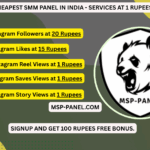Are you ready to level up your social media game? In this article, I’ll share the top strategies for maximizing your use of social media management panels. From scheduling posts to analyzing performance, I’ve got you covered. Let’s dive in and take your social media presence to the next level.
Navigating the world of social media management tools can be overwhelming, but with the right strategies, you can streamline your workflow and see real results. I’ll walk you through how to make the most of your social media management panel, so you can spend less time on logistics and more time engaging with your audience.
Whether you’re a seasoned social media pro or just starting out, these strategies will help you make the most of your social media management panel. Get ready to boost your online presence and connect with your followers like never before.
Understanding Social Media Management Panels
When entering the realm of social media management, it’s crucial to comprehend the functionalities of social media management panels. These platforms serve as central hubs where I can oversee and coordinate all aspects of my social media presence. From scheduling posts to monitoring analytics, a powerful social media management panel streamlines my workflow and enables me to efficiently engage with my audience.
With a user-friendly interface, social media management panels provide me with a comprehensive overview of all my social media accounts in one place. This unified dashboard simplifies the process of posting content across multiple platforms and ensures consistency in my messaging.
One of the key advantages of utilizing social media management panels is the ability to schedule posts in advance. By planning and scheduling my content calendar, I can maintain a consistent posting schedule, even during peak engagement times when my audience is most active. This strategic approach helps me maximize reach and engagement with my followers.
Additionally, social media management panels offer robust analytics tools that allow me to track the performance of my posts and campaigns. By analyzing key metrics such as engagement rates, click-through rates, and audience demographics, I can gain valuable insights into what content resonates with my audience and make data-driven decisions to optimize my social media strategy.
In essence, a solid understanding of social media management panels empowers me to efficiently manage my social media presence, streamline my workflow, and ultimately drive meaningful results in engaging with my audience.
Scheduling Posts Effectively

When it comes to scheduling posts, I cannot stress enough the importance of planning ahead and being consistent with your content. By utilizing the scheduling feature on social media management panels, you can save time and ensure a steady flow of posts without having to be constantly glued to your devices.
One of my top strategies for Scheduling Posts Effectively is to leverage analytics data to determine the best times to reach your audience. By identifying peak engagement times, you can schedule your posts during periods when your followers are most active, increasing the likelihood of interaction and visibility.
Another key tip for scheduling posts is to create a content calendar. This helps you organize your posts, maintain a consistent posting schedule, and ensure that you cover a variety of topics to keep your audience engaged.
Additionally, consider batching your content creation and scheduling multiple posts at once. This allows you to stay ahead of your posting schedule and frees up time for other important tasks.
Remember, consistency is key when it comes to social media management. Establishing a regular posting schedule not only keeps your audience engaged but also signals to social media algorithms that your account is active and relevant.
By implementing these strategies for Scheduling Posts Effectively, you can streamline your social media efforts, improve engagement rates, and ultimately grow your online presence.
Analyzing Performance Metrics

When it comes to optimizing social media management, Analyzing Performance Metrics plays a crucial role. By monitoring key metrics such as engagement rates, click-through rates, and audience demographics, I can gain valuable insights into how my content is resonating with my followers.
Through platforms’ built-in analytics tools or third-party software, I track these metrics to understand what content performs best, when my audience is most active, and how to adjust my strategy for maximum impact. This data-driven approach helps me make informed decisions and fine-tune my social media posts for optimal reach.
Key performance indicators (KPIs) provide quantitative measurements of my social media efforts. By setting goals and monitoring progress towards them, I can evaluate the effectiveness of my strategies and identify areas for improvement. Regularly reviewing these metrics enables me to pivot based on real-time data and stay ahead in the ever-evolving social media landscape.
Analyzing Performance Metrics also allows me to identify trends and emerging patterns in my audience’s behavior. By leveraging this insight, I can tailor my content to better resonate with my followers and foster stronger connections. This data-driven approach not only enhances my online presence but also boosts engagement and fosters a loyal community of followers.
Implementingperformance metric analysis as a core component of my social media strategy ensures that I optimize my efforts, consistently deliver valuable content, and continuously grow my online presence.
Engaging with Your Audience

Engaging with your audience is essential for successful social media management panel use. By fostering interaction and building relationships with your followers, you can increase engagement and create a loyal community. Here are some strategies to effectively engage with your audience:
- Interactive Content: Create polls, quizzes, and interactive stories to encourage participation and increase engagement.
- Respond Promptly: Engage with comments, messages, and mentions in a timely manner to show that you value your audience’s feedback.
- Ask Questions: Encourage conversations by asking questions and seeking input from your followers.
- User-Generated Content: Implement user-generated content campaigns to involve your audience in creating and sharing content.
- Live Q&A Sessions: Host live Q&A sessions to interact with your audience in real-time and address their queries directly.
By implementing these strategies, you can build a strong connection with your audience, boost engagement, and create a positive online community.
Optimizing Workflow Efficiency
When it comes to social media management panel use, efficiency is key. Here are some strategies that I’ve found useful for optimizing workflow efficiency:
- Content Calendars: Planning ahead and scheduling posts in advance can save a lot of time and keep your social media presence consistent.
- Automation Tools: Utilizing automation tools like Hootsuite or Buffer can help in scheduling posts, monitoring activities, and analyzing performance.
- Analytics Monitoring: Regularly tracking and analyzing metrics such as engagement rates, reach, and follower growth can provide valuable insights to refine your social media strategy.
- Team Collaboration: Working collaboratively with team members can streamline tasks, ensure consistency in messaging, and foster creativity.
- Audience Segmentation: Tailoring content based on audience segments can boost relevance and engagement, making your social media efforts more effective.
- Clear Communication Channels: Establishing clear communication channels within your team can prevent misunderstandings and ensure quick decision-making.
- Continuous Learning: Staying updated with the latest trends and social media algorithms is essential to adapt and optimize your strategy for better results.
Monitoring metrics, collaborating with the team, and staying informed are essential practices that have helped me enhance workflow efficiency in social media management.
Key Takeaways
- Understanding the functionalities of social media management panels is crucial for streamlining workflow and engaging with the audience effectively.
- Scheduling posts strategically by leveraging analytics data, creating a content calendar, and batch content creation can improve engagement and visibility.
- Analyzing performance metrics like engagement rates and audience demographics is essential for making informed decisions, adjusting strategies, and enhancing online presence.
- Engaging with the audience through interactive content, prompt responses, questions, user-generated content, and live Q&A sessions can foster strong relationships and boost engagement.
- Optimizing workflow efficiency with strategies such as content calendars, automation tools, analytics monitoring, team collaboration, audience segmentation, clear communication channels, and continuous learning can improve productivity and results in social media management.
Conclusion
Implementing these strategies can significantly boost your social media management efficiency. Utilizing content calendars, automation tools, analytics monitoring, team collaboration, audience segmentation, clear communication channels, and continuous learning are key to success. By monitoring metrics, collaborating effectively, and staying updated, you’ll streamline your workflow and achieve optimal results. Stay proactive and adaptable in your approach to social media management to stay ahead of the curve. Remember, efficiency is the cornerstone of effective social media management.
Frequently Asked Questions
What are some strategies to optimize workflow efficiency in social media management?
To optimize workflow efficiency in social media management, consider using content calendars, automation tools, analytics monitoring, team collaboration, audience segmentation, clear communication channels, and continuous learning. These strategies help streamline processes and enhance productivity.
Why is monitoring metrics important in social media management?
Monitoring metrics is crucial in social media management as it allows you to track the performance of your campaigns, understand audience behavior, and make data-driven decisions. Analyzing metrics helps in measuring the success of social media efforts and optimizing strategies for better results.
How can team collaboration improve workflow efficiency in social media management?
Team collaboration plays a vital role in improving workflow efficiency in social media management by fostering communication, sharing insights, distributing tasks effectively, and pooling expertise. Collaborating with team members leads to better coordination, increased creativity, and streamlined processes for successful social media campaigns.
What role does continuous learning play in enhancing workflow efficiency in social media management?
Continuous learning is essential in enhancing workflow efficiency in social media management as it helps professionals stay updated on industry trends, best practices, and new technologies. By investing in learning opportunities, individuals can acquire new skills, improve strategies, and adapt to the evolving landscape of social media platforms.







